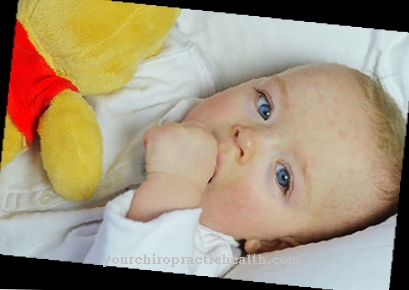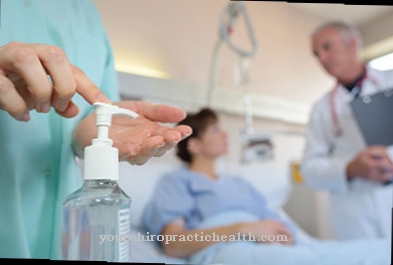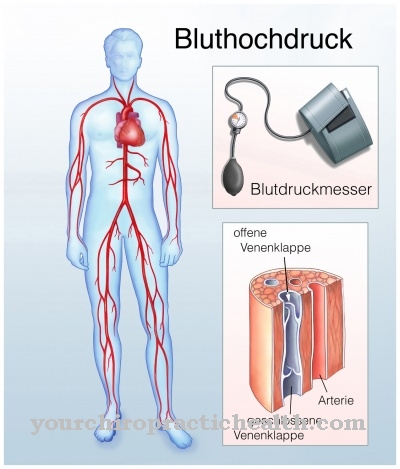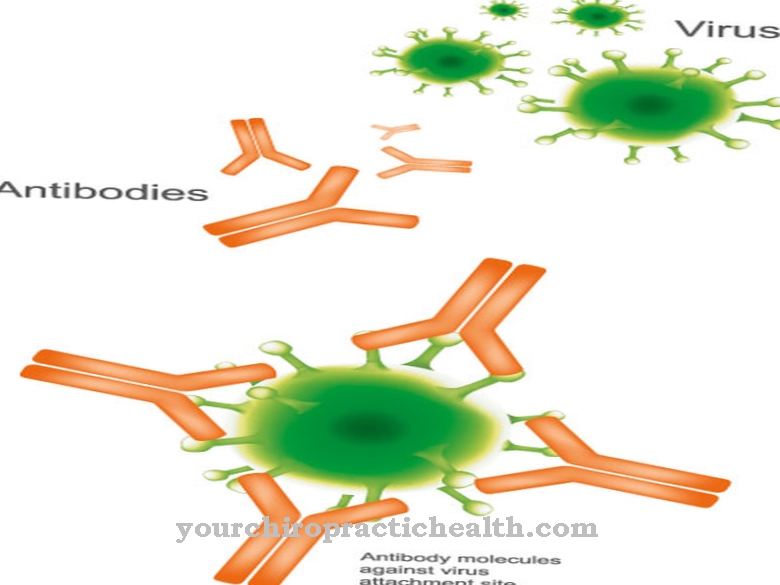Trisomy 13, also as Patau syndrome known is a rare genetic defect in which chromosome 13 occurs three times instead of the usual two. It leads to a multitude of different diseases and physical characteristics, most of which lead to death in early childhood. After Down syndrome and trisomy 18, trisomy 13 is one of the best-known triple abnormalities.
What is trisomy 13?
With a person with Trisomy 13 Chromosome 13 is present three times. It has 47 instead of 46 chromosomes. A distinction is made between different types of Patau syndrome.
This depends on whether all cells of the organism are affected by trisomy 13 or only a part. The severity of the defects resulting from the trisomy varies. It includes growth disorders as well as excess fingers or toes or malformations of the face.
If trisomy 13 occurs, the life expectancy of the affected child is drastically reduced. Few of them live to be over 10 years old. Most children with trisomy 13 die within weeks or months of birth.
causes
The causes of Trisomy 13 are primarily in the deviating chromosome division. This does not yet explain how this discrepancy occurs. There are indications that the occurrence of trisomy 13 could be linked to the increased age of the child's mother.
Depending on the type of trisomy 13, there are already indications of a form of trisomy 13 in the mother's genome. The symptoms of Patau's syndrome are caused by the excess chromosome in different forms. They are at least pronounced in a mosaic trisomy 13. In this variant, the chromosome pairs are not separated and three chromosomes are not formed in one cell in only some of the cells.
The course of a partial trisomy 13 is similarly weakened, in which chromosome 13 is only partially changed in the cells of the embryo during pregnancy.
Symptoms, ailments & signs
The disease causes numerous symptoms, both in appearance and in the internal organs. The common appearance of three signs is considered characteristic. The first is the cleft lip and palate, where a gap runs through the upper jaw, upper lip, and roof of the mouth. Colloquially, this malformation is called a harelip. The second sign is microcephaly (small head) and microphthalmia (small eyes).
The small head has an abnormal skull shape and causes the brain to grow less. The small eyes are often only reduced, there may be ametropia or blindness. It is also possible for the two eyes to merge into a single one (cyclopia).
The third symptom of the triple complex is additional fingers or toes (polydactyly). Usually there is a sixth link on the hands or feet, so that twelve fingers or twelve toes are laid out. In addition to these typical signs, the heart can also be malformed.
Often a ventricular septum defect occurs, in which there is damage to the septum between the heart chambers. They can lead to an enlarged heart and pulmonary hypertension. The ears are exceptionally deep and the nose is flat or absent. Malformations of the cranial nerves, the brain, the kidneys, the bladder, the sexual organs, the blood vessels and the skeleton are also among the symptoms of the disease.
Diagnosis & course
A Patau syndrome can already be recognized during pregnancy. During prenatal diagnosis, the gynecologist examines deviations in the development of the fetus. If he detects special features that are particularly characteristic of Patau's syndrome, a chromosome analysis follows, as is also carried out if Down's syndrome is suspected.
The indications of the Patau syndrome include, in particular, heart defects in the fetus or developmental disorders and deviations in the amount of amniotic fluid in pregnant women. The prognosis for a child born with trisomy 13 is poor.
Mortality is very high in the first few weeks of life. The malformations are often life-threatening as they affect not only the extremities but also the internal organs such as the heart and kidneys. Trisomy 13 is considered a medical reason for an abortion.
Complications
Trisomy 13 generally leads to a number of different malformations and deformities on the person's body. The patients also suffer from serious disorders of growth and development. Immediately after birth, the children are severely underweight and also suffer from a developmental disorder of the brain.
This leads to mental retardation and severe restrictions in everyday life. Most of those affected are dependent on the help of other people in their everyday life due to trisomy 13. In some cases, the condition also causes those affected to have six fingers. Especially in childhood, the disease can lead to bullying or teasing due to the malformations and thus also cause psychological complaints.
As a rule, the parents and relatives in trisomy 13 also suffer from severe psychological complaints. The life expectancy of the child is also significantly reduced due to the malformations in the internal organs. Since a causal treatment of the syndrome is not possible, only the symptoms are treated. There are no particular complications. The diagnosis of trisomy 13 often leads to termination of the pregnancy.
When should you go to the doctor?
The affected person must contact a doctor in any case with trisomy 13. This disease cannot heal itself, so medical treatment must always be carried out. The earlier the disease is recognized and treated, the better the further course will usually be. In most cases, however, the disease causes death in childhood.
Therefore, parents and relatives in particular are dependent on psychological treatment so that there are no depression or other psychological upsets. A doctor should be consulted for trisomy 13 if the person concerned suffers from a malformation of the face. The head of the person concerned is usually very small, and the eyes are also significantly smaller. Furthermore, a malformation of the heart can indicate the disease and must be examined by a doctor.
The disease can be detected by a pediatrician. However, further treatment is carried out by a specialist. If the parents want to have children again, genetic counseling should also be carried out in order to prevent trisomy 13 from recurring.
Treatment & Therapy
A treatment at Trisomy 13 depends on the defects that exist in the individual case. Because of the high mortality rate, symptoms are mostly only alleviated.
If children with trisomy 13 are born alive, medical care must always be arranged individually. In Patau syndrome, malformations in the form of a cleft lip and palate often occur. One of the necessary therapies is to increase language skills. There is also movement therapy and social and psychological support for parents who are confronted with caring for their children.
Surgical interventions to correct the malformations in Patau syndrome are still rare. However, there has been a change in medical treatment. This increases the life expectancy of children suffering from trisomy 13, even if it cannot yet be assessed as particularly high.
prevention
Will the Trisomy 13 Determined in good time before the birth, the question of terminating the pregnancy often arises. However, real prevention to prevent trisomy 13 is not possible because the development is beyond the control of the parents. On the other hand, the likelihood of recurrence of trisomy 13 in a new pregnancy is only slightly increased.
Aftercare
As the life expectancy of children with trisomy 13 is low, psychological support for parents and other family members plays an important role in follow-up care. With sensitive and professional support, the difficult situation can be better mastered by everyone involved.
Care for parents and siblings should not stop even after the death of the affected child. How long the follow-up care makes sense cannot be determined across the board. It depends on the individual family situation as well as on the wishes of the relatives. Medical follow-up care is primarily about offering children with Pätau syndrome the best possible quality of life.
Existing physiological defects should be examined regularly. In this way, it can be determined at an early stage if the patient's condition has deteriorated. If a new pregnancy occurs after a woman has given birth to a child with trisomy 13, the risk of this genetic defect recurring is only slightly increased. Special measures are therefore not required.
Many families still take genetic counseling to help them feel more secure. During a subsequent pregnancy, a new trisomy 13 can be excluded by examining the amniotic fluid. However, those involved should always bear in mind that this examination increases the risk of a miscarriage.
You can do that yourself
It is important to know that trisomy 13 is not just about the child. The (future) parents must also be viewed as suffering in this difficult situation. Psychological support may be required in order to be able to cope better with dealing with the disease. In many medical institutions and special clinics, parents are therefore provided with a psychologist to accompany them. This makes it easier for many to enjoy the time they can have with their child.
But even with the diagnosis of trisomy 13, many parents suffer from restlessness, insomnia and deep sadness. However, so that they can still enjoy the limited time with their baby, small home remedies can bring some relief for some. These include medicinal plants and herbs that have a calming effect. Lavender is best known here. Essential oils can also provide a bit of relaxation.
It gives many parents a good feeling to know that they are not alone in their situation. There are various networks for exchange on the Internet. Here you can find testimonials from pregnancy and the time with the child. The association for family self-help LEONA e.V. offers not only a lot of information but also a network that enables exchange with other affected parents.

.jpg)











.jpg)

.jpg)
.jpg)











.jpg)